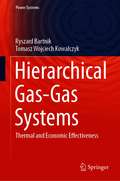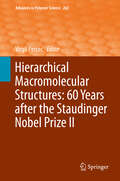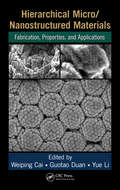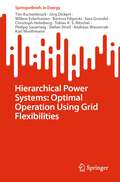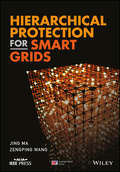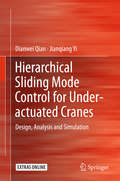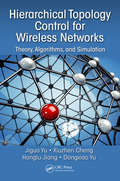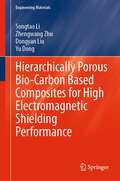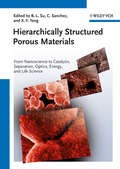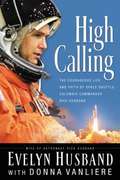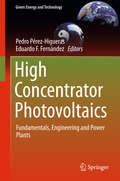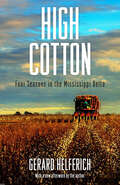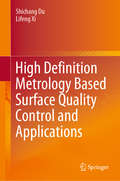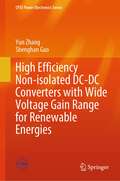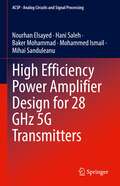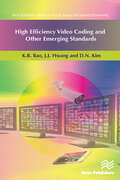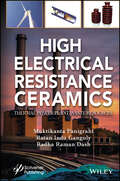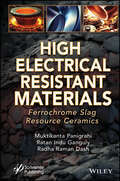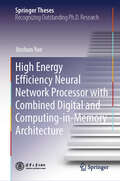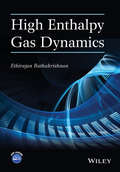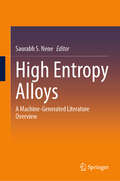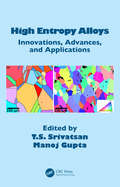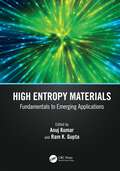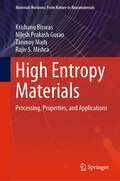- Table View
- List View
Hierarchical Gas-Gas Systems: Thermal and Economic Effectiveness (Power Systems)
by Ryszard Bartnik Tomasz Wojciech KowalczykThis book presents a thermodynamic and economic analysis of gas-gas systems in power plants, including combined heat and power systems, combined cooling, heat and power systems, hydrogen production facilities and compressed energy storage system. A configuration for high-temperature gas-cooled nuclear reactor is also used as a heat source for the cycle.The book compares different technologies, such as gas-steam and gas-gas systems, using optimized cases. It presents mathematical models that return optimal thermodynamic parameters of the cycles, and applies a novel continuous-time model in order to perform an economic analysis as well. This book utilizes numerous illustrations and worked examples to thoroughly explain the technologies discussed, making it relevant for researchers, market analysts, decision makers, power engineers and students alike.
Hierarchical Macromolecular Structures: 60 Years after the Staudinger Nobel Prize I
by Virgil PercecAdvances in Polymer Science enjoys a longstanding tradition and good reputation in its community. Each volume is dedicated to a current topic, and each review critically surveys one aspect of that topic, to place it within the context of the volume. The volumes typically summarize the significant developments of the last 5 to 10 years and discuss them critically, presenting selected examples, explaining and illustrating the important principles, and bringing together many important references of primary literature. On that basis, future research directions in the area can be discussed. Advances in Polymer Science volumes thus are important references for every polymer scientist, as well as for other scientists interested in polymer science - as an introduction to a neighboring field, or as a compilation of detailed information for the specialist.
Hierarchical Micro/Nanostructured Materials: Fabrication, Properties, and Applications (Advances in Materials Science and Engineering)
by Weiping Cai Guotao Duan Yue LiHierarchical Micro/Nanostructured Materials: Fabrication, Properties, and Applications presents the latest fabrication, properties, and applications of hierarchical micro/nanostructured materials in two sections-powders and arrays. After a general introduction to hierarchical micro/nanostructured materials, the first section begins with a detailed
Hierarchical Power Systems: Optimal Operation Using Grid Flexibilities (SpringerBriefs in Energy)
by Karl Worthmann Sara Grundel Tim Aschenbruck Jörg Dickert Willem Esterhuizen Bartosz Filipecki Christoph Helmberg Tobias K. Ritschel Philipp Sauerteig Stefan Streif Andreas WasserrabThis book explains the power grid as a hierarchy made up of the transmission, distribution, and microgrid levels. Interfaces among these levels are explored to show how flexibility in power demand associated with residential batteries can be communicated through the entire grid to facilitate optimal power flow computations within the transmission grid. To realize this approach, the authors combine semi-definite optimal power flow with model-order reduction at the distribution level and with a new heuristic algorithm for stable power flow at the transmission level. To demonstrate its use, a numerical case study based on modified IEEE 9-bus and 33-bus systems for the transmission and distribution grid, respectively, is included. This book shows how exploiting the flexibility on the residential level improves the performance of the power flow with the transmission grid.
Hierarchical Protection for Smart Grids (Wiley - Ieee Ser.)
by Jing Ma Zengping WangA systematic view of hierarchical protection for smart grids, with solutions to tradition protection problems and complicated operation modes of modern power systems • Systematically investigates traditional protection problems from the bird’s eye view of hierarchical protection • Focuses on multiple variable network structures and complicated operation modes • Offers comprehensive countermeasures on improving protection performance based on up-to-date research
Hierarchical Sliding Mode Control for Under-actuated Cranes
by Dianwei Qian Jianqiang YiThis book reports on the latest developments in sliding mode overhead crane control, presenting novel research ideas and findings on sliding mode control (SMC), hierarchical SMC and compensator design-based hierarchical sliding mode. The results, which were previously scattered across various journals and conference proceedings, are now presented in a systematic and unified form. The book will be of interest to researchers, engineers and graduate students in control engineering and mechanical engineering who want to learn the methods and applications of SMC.
Hierarchical Topology Control for Wireless Networks: Theory, Algorithms, and Simulation
by Jiguo Yu Cheng Xiuzhen Jiang Honglu Dongxiao YuFirst Published in 2018. Routledge is an imprint of Taylor & Francis, an Informa company.
Hierarchically Porous Bio-Carbon Based Composites for High Electromagnetic Shielding Performance (Engineering Materials)
by Yu Dong Songtao Li Zhengwang Zhu Dongyan LiuThis book highlights the preparation and characterization of efficient electromagnetic shielding composites containing bio-carbon derived from natural loofah with unique three-dimensional porous structures by means of entire structure design of composites according to shielding theory. The synergistic effect of multifunctional nanoparticles and bio-carbon on electromagnetic shielding mechanism, mechanical performance, and thermal stability of composites obtained has been holistically investigated. The discovery of this renewable, environmentally friendly, and inexpensive bio-carbon represents a new class of conductive materials with multi-interfaces and unravels further research and development of a wide variety of new electromagnetic shielding material systems with potential commercial applications ranging from electronic devices to energy management.
Hierarchically Structured Porous Materials
by Xiao-Yu Yang B. L. Su Clement SanchezThis first book devoted to this hot field of science covers materials with bimodal, trimodal and multimodal pore size, with an emphasis on the successful design, synthesis and characterization of all kinds of hierarchically porous materials using different synthesis strategies. It details formation mechanisms related to different synthesis strategies while also introducing natural phenomena of hierarchy and perspectives of hierarchical science in polymers, physics, engineering, biology and life science. Examples are given to illustrate how to design an optimal hierarchically porous material for specific applications ranging from catalysis and separation to biomedicine, photonics, and energy conversion and storage. With individual chapters written by leading experts, this is the authoritative treatment, serving as an essential reference for researchers and beginners alike.
High Calling: The Courageous Life and Faith of Space Shuttle Columbia Commander Rick Husband
by Donna Vanliere Evelyn HusbandRick Husband wanted to be an astronaut since his fourth birthday, but it wasn't always for the right reasons. Initially, he thought it would be neat . . . cool . . . a fun thing to do. It wasn't until he came to a spiritual crossroads and was able to give that dream up to discover the true desires of his heart before he actually got into the space shuttle program at NASA. Three failed attempts didn't daunt this driven pilot-and the fourth interview process, though lengthy and difficult, proved successful for him. Husband's years at NASA served not only to develop his integrity and character, but also to increase his faith in a Creator that could not be denied in the vastness of space. His story is not only inspirational but exhilarating and invigorating, as readers will witness the life of a man who consistently pursued the desires of his heart even as he served a faithful God.
High Concentrator Photovoltaics
by Pedro Pérez-Higueras Eduardo F. FernándezThe aim of this book is to provide a comprehensive overview of the fundamentals and engineering of high concentrator photovoltaic (HCPV) technology and to elucidate how this complex and emerging technology is applied in power plants. It is the first of its kind to focus exclusively on HCPV technology and offers a valuable reference volume to readers. This book is the result of an international collaboration among experts and each chapter is written by a specialist in the field. The conversion of solar energy to electricity plays an important role in power generation and HCPV is signalled by many researchers and professionals as one of the most promising sources of solar power. Therefore this book provides an important resource for companies, research institutes and universities to assist with the understanding of fundamentals, different applications and potential of such technology.
High Cotton: Four Seasons in the Mississippi Delta (Banner Books)
by Gerard HelferichThis dirt-under-the-fingernails portrait of a small-time farmer follows Zack Killebrew over a single year as he struggles to defend his cotton against such timeless adversaries as weeds, insects, and drought, as well as such twenty-first-century threats as globalization. Over the course of the season, Helferich describes how this singular crop has stamped American history and culture like no other. Then, as Killebrew prepares to harvest his cotton, two hurricanes named Katrina and Rita devastate the Gulf Coast and barrel inland. Killebrew's tale is at once a glimpse into our nation's past, a rich commentary on our present, and a plain-sighted vision of the future of farming in the Mississippi Delta.On first publication, High Cotton won the Authors Award from the Mississippi Library Association. This updated edition includes a new afterword, which resumes the story of Zack Killebrew and his family, discusses how cotton farming has continued to change, and shows how the Delta has retained its elemental character.
High Definition Metrology Based Surface Quality Control and Applications
by Shichang Du Lifeng XiThis book provides insights into surface quality control techniques and applications based on high-definition metrology (HDM). Intended as a reference resource for engineers who routinely use a variety of quality control methods and are interested in understanding the data processing, from HDM data to final control actions, it can also be used as a textbook for advanced courses in engineering quality control applications for students who are already familiar with quality control methods and practices. It enables readers to not only assimilate the quality control methods involved, but also to quickly implement the techniques in practical engineering problems. Further, it includes numerous case studies to highlight the implementation of the methods using measured HDM data of surface features. Since MATLAB is extensively employed in these case studies, familiarity with this software is helpful, as is a general understanding of surface quality control methods.
High Efficiency Non-isolated DC-DC Converters with Wide Voltage Gain Range for Renewable Energies (CPSS Power Electronics Series)
by Yun Zhang Shenghan GaoThe book focuses on the topologies of non-isolated DC-DC converters with a wide voltage gain range for renewable energy systems. It addresses both theoretical principles and engineering practices. Each chapter introduces a family of non-isolated DC-DC converters, including advanced control methods. The inclusion of modeling and experimental verification provides in-depth applications in fuel cell vehicles, electric vehicles with multiple sources including batteries and super-capacitors, and photovoltaic systems. The book is beneficial for researchers, engineers, and graduate students in the fields of renewable energies, as well as electrical and electronic engineering.
High Efficiency Power Amplifier Design for 28 GHz 5G Transmitters (Analog Circuits and Signal Processing)
by Mohammed Ismail Baker Mohammad Hani Saleh Nourhan Elsayed Mihai SanduleanuThis book introduces power amplifier design in 22nm FDSOI CMOS dedicated towards 5G applications at 28 GHz and presents 4 state-of-the-art power amplifier designs. The authors discuss power amplifier performance metrics, design trade-offs, and presents different power amplifier classes utilizing efficiency enhancement techniques at 28 GHz. The book presents the design process from theory, simulation, layout, and finally measurement results.
High Efficiency Video Coding and Other Emerging Standards (River Publishers Series In Signal, Image And Speech Processing Ser.)
by K.R. Rao J.J. Hwang D.N. KimHigh Efficiency Video Coding and Other Emerging Standards provides an overview of high efficiency video coding (HEVC) and all its extensions and profiles. There are nearly 300 projects and problems included, and about 400 references related to HEVC alone. Next generation video coding (NGVC) beyond HEVC is also described. Other video coding standards such as AVS2, DAALA, THOR, VP9 (Google), DIRAC, VC1, and AV1 are addressed, and image coding standards such as JPEG, JPEG-LS, JPEG2000, JPEG XR, JPEG XS, JPEG XT and JPEG-Pleno are also listed.Understanding of these standards and their implementation is facilitated by overview papers, standards documents, reference software, software manuals, test sequences, source codes, tutorials, keynote speakers, panel discussions, reflector and ftp/web sites – all in the public domain. Access to these categories is also provided.
High Electrical Resistance Ceramics: Thermal Power Plant Waste Resources
by Muktikanta Panigrahi Ratan Indu Ganguly Radha Raman DashHIGH ELECTRICAL RESISTANCE CREAMICS Pond and fly ash waste materials generated by thermal power stations pollute the environment; this book demonstrates how the utilization of these materials minimizes environmental pollution and conserves land for cultivation. This book highlights the preparation of ceramics using pond/fly ash. Since the mullite phase formed by heat treatment improves the properties of ceramics, current investigations will perhaps be the first attempt to develop ceramics using pond ash. The properties of components made with these developed ceramics are found to be comparable to those made with porcelain. The extensively reviewed chapters of this book illustrate the current status of research on these materials. At the end of each of the 10 chapters, conclusions are drawn which will benefit researchers working in this area. Subjects discussed include: The fundamentals of thermal power plant wastes; Different production methods of ceramics and various characterization techniques; The preparation of ceramics from fly ash and fly ash/kaolin composite; The production of ceramics using pond ash; The preparation and characterization of geopolymer from pond ash and the preparation of pond ash composite; Production of ceramic matrix composite (CMC) using pond ash and pyrophyllite; The preparation of ceramics using pond ash and k-feldspar mixture. Audience The book will be used by civil engineers in the construction and ceramic industries as well as the industrial waste sector. Researchers in materials science, structural, civil and electrical engineering, environmental science, and ceramic engineering, will also have interest. Industries that have an interest include construction, electrical, and ceramic industries as well as pollution and waste sectors.
High Electrical Resistant Materials: Ferrochrome Slag Resource Ceramics
by Muktikanta Panigrahi Ratan Indu Ganguly Radha Raman DashHIGH ELECTRICAL RESISTANT MATERIALS The book describes how the utilization of high-carbon slag/pond ash/fly ash for making value-added ceramics is useful for the electrical sectors. Since waste materials are currently endangering our environment, ways of utilizing them have become a global challenge. Currently, R&D work is being carried out to utilize these materials for producing value-added products. This book details the investigations to utilize fly ash (FA) and pond ash (PA) - both waste materials from thermal power plants - with high-carbon ferrochrome (HCFC) slag (by-product of the ferrochrome industry), for producing a novel material for ceramics. Kaolin/K-feldspar is mixed with PA/HCFC slag to produce ceramics with the formation of mullite. The FA/PA/HCFC slag-based ceramics can replace porcelain-based ceramics, and some permanent ceramic structures can be constructed with such wastes. Properties and structures made with ceramics are found to be comparable with those made with porcelain-based ceramics. Performances of these materials above ambient temperature have been evaluated and results indicate the possible replacement of porcelain with these newly invented ceramics. Audience The book will be used by electrical and civil engineers in the electrical, construction, and ceramic industries as well as the industrial waste sector. Researchers in materials science, structural, civil and electrical engineering, environmental science, and ceramic engineering, will also have high interest.
High Energy Efficiency Neural Network Processor with Combined Digital and Computing-in-Memory Architecture (Springer Theses)
by Jinshan YueNeural network (NN) algorithms are driving the rapid development of modern artificial intelligence (AI). The energy-efficient NN processor has become an urgent requirement for the practical NN applications on widespread low-power AI devices. To address this challenge, this dissertation investigates pure-digital and digital computing-in-memory (digital-CIM) solutions and carries out four major studies. For pure-digital NN processors, this book analyses the insufficient data reuse in conventional architectures and proposes a kernel-optimized NN processor. This dissertation adopts a structural frequency-domain compression algorithm, named CirCNN. The fabricated processor shows 8.1x/4.2x area/energy efficiency compared to the state-of-the-art NN processor. For digital-CIM NN processors, this dissertation combines the flexibility of digital circuits with the high energy efficiency of CIM. The fabricated CIM processor validates the sparsity improvement of the CIM architecture for the first time. This dissertation further designs a processor that considers the weight updating problem on the CIM architecture for the first time. This dissertation demonstrates that the combination of digital and CIM circuits is a promising technical route for an energy-efficient NN processor, which can promote the large-scale application of low-power AI devices.
High Enthalpy Gas Dynamics
by Ethirajan RathakrishnanThis is an introductory level textbook which explains the elements of high temperature and high-speed gas dynamics. written in a clear and easy to follow style, the author covers all the latest developments in the field including basic thermodynamic principles, compressible flow regimes and waves propagation in one volume covers theoretical modeling of High Enthalpy Flows, with particular focus on problems in internal and external gas-dynamic flows, of interest in the fields of rockets propulsion and hypersonic aerodynamics High enthalpy gas dynamics is a compulsory course for aerospace engineering students and this book is a result of over 25 years' teaching by the author accompanying website includes a Solutions Manual for exercises listed at the end of each chapter, plus lecture slides
High Entropy Alloys: A Machine-Generated Literature Overview
by Saurabh S. NeneThis book presents the result of an innovative challenge, to create a systematic literature overview driven by machine-generated content. Questions and related keywords were prepared for the machine to query, discover, collate and structure by Artificial Intelligence (AI) clustering. The AI-based approach seemed especially suitable to provide an innovative perspective as the topics are indeed both complex, interdisciplinary and multidisciplinary, for example, climate, planetary and evolution sciences. Springer Nature has published much on these topics in its journals over the years, so the challenge was for the machine to identify the most relevant content and present it in a structured way that the reader would find useful. The automatically generated literature summaries in this book are intended as a springboard to further discoverability. They are particularly useful to readers with limited time, looking to learn more about the subject quickly and especially if they are new to the topics. Springer Nature seeks to support anyone who needs a fast and effective start in their content discovery journey, from the undergraduate student exploring interdisciplinary content to Master- or PhD-thesis developing research questions, to the practitioner seeking support materials, this book can serve as an inspiration, to name a few examples. It is important to us as a publisher to make the advances in technology easily accessible to our authors and find new ways of AI-based author services that allow human-machine interaction to generate readable, usable, collated, research content.
High Entropy Alloys: Innovations, Advances, and Applications
by Manoj Gupta T. S. SrivatsanThis book provides a cohesive overview of innovations, advances in processing and characterization, and applications for high entropy alloys (HEAs) in performance-critical and non-performance-critical sectors. It covers manufacturing and processing, advanced characterization and analysis techniques, and evaluation of mechanical and physical properties. With chapters authored by a team of internationally renowned experts, the volume includes discussions on high entropy thermoelectric materials, corrosion and thermal behavior of HEAs, improving fracture resistance, fatigue properties and high tensile strength of HEAs, HEA films, and more. This work will be of interest to academics, scientists, engineers, technologists, and entrepreneurs working in the field of materials and metals development for advanced applications. Features Addresses a broad spectrum of HEAs and related aspects, including manufacturing, processing, characterization, and properties Emphasizes the application of HEAs Aimed at researchers, engineers, and scientists working to develop materials for advanced applications T.S. Srivatsan, PhD, Professor of Materials Science and Engineering in the Department of Mechanical Engineering at the University of Akron (Ohio, USA), earned his MS in Aerospace Engineering in 1981 and his PhD in Mechanical Engineering in 1984 from the Georgia Institute of Technology (USA). He has authored or edited 65 books, delivered over 200 technical presentations, and authored or co-authored more than 700 archival publications in journals, book chapters, book reviews, proceedings of conferences, and technical reports. His RG score is 45 with a h-index of 53 and Google Scholar citations of 9000, ranking him to be among the top 2% of researchers in the world. He is a Fellow of (i) the American Society for Materials International, (ii) the American Society of Mechanical Engineers, and (iii) the American Association for Advancement of Science. Manoj Gupta, PhD, is Associate Professor of Materials at NUS, Singapore. He is a former Head of Materials Division of the Mechanical Engineering Department and Director Designate of Materials Science and Engineering Initiative at NUS, Singapore. In August 2017, he was highlighted among the Top 1% Scientists of the World by the Universal Scientific Education and Research Network and in the Top 2.5% among scientists as per ResearchGate. In 2018, he was announced as World Academy Championship Winner in the area of Biomedical Sciences by the International Agency for Standards and Ratings. A multiple award winner, he actively collaborates/visits as an invited researcher and visiting and chair professor in Japan, France, Saudi Arabia, Qatar, China, the United States, and India.
High Entropy Materials: Fundamentals to Emerging Applications
by Ram K. GuptaHigh Entropy Materials covers the fundamental concepts of these materials and their emerging applications. To fulfil growing energy demand, scientists are looking for novel materials which can be used for the fabrication of high-performance energy devices. Many materials such as graphene, carbon nanotubes, and metal oxides are used in energy production and storage. A new class of metal oxides, multicomponent metal oxides, known as high entropy materials, have attracted considerable attention not only for their energy applications but also other emerging applications such as use in sensors, catalysts, and CO2 absorption.Key Features: Reviews state-of-the-art developments Provides new directions to scientists, researchers, and students to better understand the principles, technologies, and applications of high entropy materials Discusses ongoing challenges and visions for the future
High Entropy Materials: Processing, Properties, and Applications (Materials Horizons: From Nature to Nanomaterials)
by Rajiv S. Mishra Krishanu Biswas Nilesh Prakash Gurao Tanmoy MaitiThis book provides a detailed overview of high entropy materials and alloys, discussing their structure, the processing of bulk and nanostructured alloys as well as their mechanical and functional properties and applications. It covers the exponential growth in research which has occurred over the last decade, discussing novel processing techniques, estimation of mechanical, functional and physical properties, and utility of these novel materials for various applications. Given the expanding scope of HEAs in ceramics, polymers, thin films and coating, this book will be of interest to material scientists and engineers alike.
High Field Plasmonics
by Luca FedeliThis thesis describes pioneering research on the extension of plasmonics schemes to the regime of high-intensity lasers. By presenting a rich and balanced mix of experimentation, theory and simulation, it provides a comprehensive overview of the emerging field of high field plasmonics, including open issues and perspectives for future research. Combining specially designed targets and innovative materials with ultrashort, high-contrast laser pulses, the author experimentally demonstrates the effects of plasmon excitation on electron and ion emission. Lastly, the work investigates possible further developments with the help of numerical simulations, revealing the potential of plasmonics effects in the relativistic regime for advances in laser-driven sources of radiation, and for the manipulation of extreme light at the sub-micron scale.
